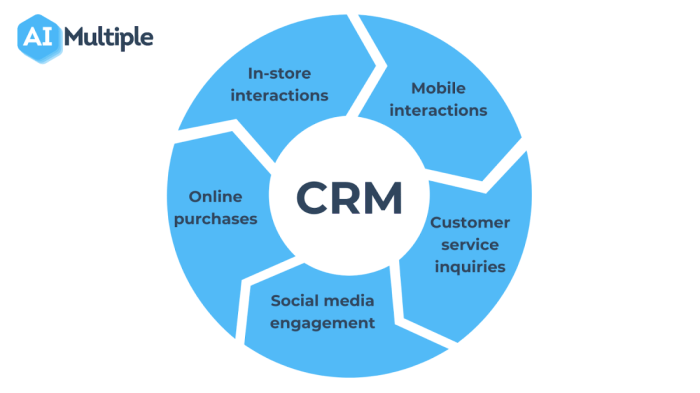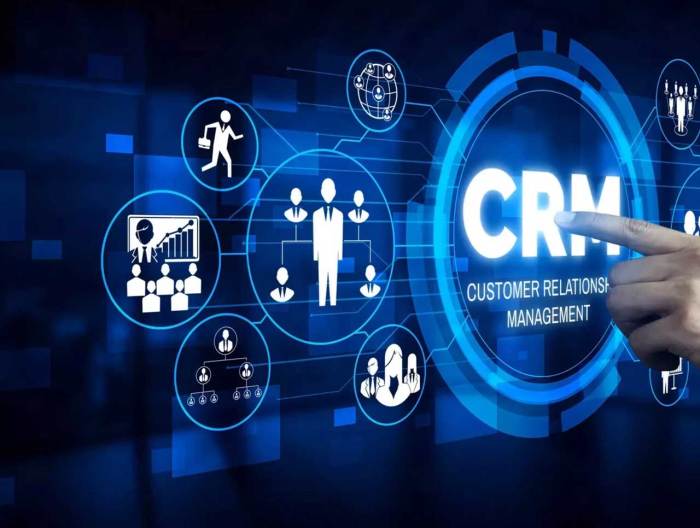CRM software for retail businesses is revolutionizing how retailers connect with customers. This guide delves into the various types of CRM software available, from cloud-based solutions to on-premise systems, highlighting their unique strengths and weaknesses. We’ll explore essential features, integration with existing retail systems like POS and inventory management, and the crucial role CRM plays in building lasting customer relationships.
Ultimately, we aim to equip you with the knowledge to choose the right CRM software to optimize your retail operations and drive significant ROI.
From understanding the cost implications and calculating return on investment to implementing effective customer loyalty programs and leveraging data for personalized interactions, this guide provides a holistic overview. We’ll also examine best practices for data privacy and security, ensuring your business remains compliant while maximizing the benefits of CRM technology. Real-world case studies illustrate the transformative power of CRM in retail, showcasing tangible results achieved by businesses similar to yours.
Types of CRM Software for Retail
Retail businesses have a variety of CRM software options to choose from, each with its own strengths and weaknesses. The optimal choice depends heavily on the size, budget, and technical capabilities of the retail operation. Understanding the key differences between these types is crucial for making an informed decision.
Categorization of Retail CRM Software
| Type | Description | Pros | Cons |
|---|---|---|---|
| Cloud-Based CRM | Software hosted on a vendor’s servers, accessible via the internet. | Cost-effective, scalable, accessible from anywhere, automatic updates. | Dependence on internet connectivity, potential security concerns (depending on vendor), limited customization in some cases. |
| On-Premise CRM | Software installed and maintained on the retailer’s own servers. | Greater control over data and security, potentially more customization options. | Higher upfront costs, requires dedicated IT infrastructure and expertise, ongoing maintenance responsibilities. |
| Open-Source CRM | Software with publicly accessible source code, allowing for customization and modification. | Flexibility, cost-effective (no licensing fees), potential for community support. | Requires technical expertise to implement and maintain, limited vendor support, potential security vulnerabilities if not properly managed. |
Examples of Retail CRM Software Solutions
Many popular CRM solutions cater to retail businesses. Examples include cloud-based options like Salesforce Commerce Cloud, Shopify, and Zoho CRM; on-premise solutions such as Microsoft Dynamics 365; and open-source options like SuiteCRM.
Key Differences Between CRM Types
Cloud-based CRMs generally offer the most cost-effective and scalable solution, particularly for growing businesses. On-premise systems provide greater control but demand a significant upfront investment and ongoing IT maintenance. Open-source CRMs offer flexibility but require substantial technical expertise.
Essential Features of Retail CRM Software
Several key features are critical for a retail CRM system to effectively support business operations and enhance customer relationships. These features contribute directly to increased sales, improved customer loyalty, and streamlined processes.
Five Must-Have Features

Five essential features for retail CRM systems include contact management, sales automation, marketing automation, reporting and analytics, and customer service tools. These features are vital for efficient management of customer interactions and business processes.
Feature Comparison Across Price Tiers
| Feature | Basic Tier | Mid-Tier | Premium Tier |
|---|---|---|---|
| Contact Management | Basic contact details, limited segmentation | Advanced contact details, segmentation capabilities, contact history | 360-degree customer view, predictive analytics, integrated social media data |
| Sales Automation | Basic sales tracking | Sales forecasting, automated follow-ups, lead management | Advanced sales pipeline management, sales analytics dashboards, integration with POS systems |
| Marketing Automation | Basic email marketing | Automated email campaigns, targeted marketing based on segmentation | Personalized email marketing, A/B testing, multi-channel marketing automation |
| Reporting & Analytics | Basic sales reports | Customizable reports, sales performance dashboards | Advanced analytics, predictive modeling, ROI tracking |
| Customer Service Tools | Basic ticketing system | Live chat integration, knowledge base | Omnichannel support, self-service portal, automated responses |
Impact of Lacking Essential Features
The absence of these features can lead to inefficiencies, lost sales opportunities, poor customer service, and a lack of valuable business insights. This can negatively impact customer retention and overall business success.
Integrating CRM with Retail Operations
Seamless integration of CRM with other retail systems is crucial for a holistic view of customer interactions and business performance. This integration streamlines processes and enhances overall efficiency.
CRM and Point-of-Sale (POS) System Integration
Integrating CRM with POS systems allows for real-time data capture on customer purchases, enabling personalized marketing and improved customer segmentation. Transaction data from the POS system feeds directly into the CRM, providing a complete picture of customer buying behavior.
CRM and Inventory Management System Integration
Integration with inventory management systems ensures accurate stock levels are reflected in CRM, preventing overselling and enabling effective inventory planning. This integration allows for proactive management of stock and improved forecasting.
CRM and Enhanced Customer Service
CRM improves customer service by providing a unified view of customer interactions across all channels (online, in-store, phone). This allows for personalized service, faster resolution of issues, and proactive engagement.
CRM Software and Customer Relationship Management
Effective CRM implementation goes beyond simply using the software; it involves strategically leveraging its capabilities to build strong customer relationships and drive business growth.
Implementing a Customer Loyalty Program
- Define loyalty program goals and rewards.
- Choose a suitable CRM system with loyalty program features.
- Integrate the loyalty program with the CRM and POS systems.
- Launch the program and track customer participation.
- Analyze program performance and make adjustments as needed.
Personalizing Customer Interactions
CRM data can be used to personalize email marketing campaigns, offer targeted promotions, and provide customized customer service. For example, analyzing purchase history to recommend relevant products or sending birthday greetings based on customer profiles.
Data Privacy and Security Best Practices
- Comply with all relevant data privacy regulations (e.g., GDPR, CCPA).
- Implement robust security measures to protect customer data.
- Regularly audit data security practices.
- Provide customers with transparency about data collection and usage.
Cost and ROI of Retail CRM Software: CRM Software For Retail Businesses
Implementing a CRM system involves various costs, but the potential return on investment can be substantial. Careful planning and a clear understanding of costs are essential for successful implementation.
Cost Breakdown, CRM software for retail businesses
Costs include software licensing fees, implementation costs (consulting, customization, training), and ongoing maintenance and support fees. Cloud-based solutions typically have lower upfront costs but may have higher recurring fees. On-premise solutions have higher initial costs but potentially lower recurring fees.
Calculating ROI
ROI can be calculated by comparing the increase in revenue, reduced costs (e.g., improved efficiency, reduced customer churn), and enhanced customer lifetime value against the total cost of the CRM implementation.
Total Cost of Ownership (TCO) Comparison
Cloud-based CRM solutions generally have a lower TCO than on-premise solutions due to reduced infrastructure and maintenance costs. However, this can vary depending on specific needs and chosen vendors.
Choosing the Right CRM Software
Selecting the appropriate CRM software requires careful consideration of various factors to ensure a successful implementation that meets the specific needs of the retail business.
Decision-Making Flowchart
A flowchart would visually guide the selection process, starting with assessing business needs, evaluating available solutions based on features, budget, and scalability, followed by a trial period, and finally, implementation.
Factors to Consider
- Scalability: Ability to adapt to future growth.
- Features: Alignment with specific business needs.
- Integration capabilities: Compatibility with existing systems.
- Budget: Cost of licensing, implementation, and maintenance.
- Vendor support: Level of technical support and training offered.
Needs Assessment
A thorough needs assessment helps identify the specific requirements of the retail business, ensuring the chosen CRM system effectively addresses those needs and provides a return on investment.
Case Studies of Successful CRM Implementations in Retail
Several retail businesses have successfully leveraged CRM systems to improve customer relationships, boost sales, and streamline operations. These case studies illustrate the tangible benefits of CRM implementation.
Case Study 1: [Retailer A]
- Challenge: High customer churn rate, inefficient customer service.
- Solution: Implemented a cloud-based CRM with integrated marketing automation and customer service tools.
- Results: 20% increase in customer retention, 15% reduction in customer service response time.
Case Study 2: [Retailer B]
- Challenge: Difficulty in personalizing customer interactions, lack of customer segmentation.
- Solution: Integrated CRM with POS and loyalty program, enabling personalized marketing campaigns.
- Results: 10% increase in sales, 5% improvement in customer lifetime value.
Case Study 3: [Retailer C]
- Challenge: Inefficient inventory management, leading to stockouts and lost sales.
- Solution: Integrated CRM with inventory management system, providing real-time inventory visibility.
- Results: 8% reduction in stockouts, 7% increase in sales conversion rates.
Last Point

Implementing the right CRM software can significantly transform your retail business, fostering stronger customer relationships, streamlining operations, and ultimately boosting profitability. By carefully considering the factors Artikeld in this guide – from choosing the appropriate software type and features to integrating it seamlessly with your existing systems and prioritizing data security – you can unlock the full potential of CRM technology.
Remember that a thorough needs assessment is crucial for making an informed decision, ensuring your chosen solution aligns perfectly with your specific business requirements and objectives. The journey to optimized retail success begins with understanding and implementing the right CRM strategy.
FAQ Corner
What is the average implementation time for retail CRM software?
Implementation time varies depending on the complexity of the system and the size of the business, ranging from a few weeks to several months.
Can CRM software integrate with my existing accounting software?
Many CRM systems offer integrations with popular accounting software, streamlining financial data management. Check for specific integrations offered by your chosen CRM provider.
How can I ensure my customer data is secure within the CRM system?
Choose a reputable provider with robust security measures, including data encryption, access controls, and regular security audits. Adhere to best practices for data privacy and compliance regulations.
What are the key performance indicators (KPIs) to track after implementing CRM?
Key KPIs include customer acquisition cost, customer lifetime value, customer retention rate, sales conversion rates, and customer satisfaction scores.
